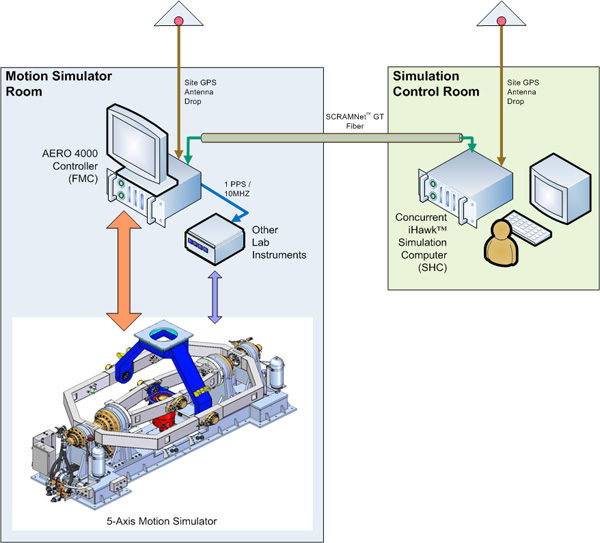
Ideal Aerosmith (Ideal) is pleased to announce the successful implementation of the “Enhanced Synchronization Module” (ESM) option in the AERO4000™ Digital Motion Controller. Ideal recently delivered AERO4000™ controllers configured with optional ESM’s for use on Ideal’s new flight motion simulation systems and also for use on existing flight motion simulation systems where theAERO4000™ controller replaced existing, obsolete motion controllers. The ESM’s were requested on AERO4000™ control systems that were purchased by U.S. Navy and U.S. Air Force facilities that perform Hardware-in-the-Loop (HWIL) simulations.
Hardware-in-the-loop (HWIL) systems can provide unique development and test capabilities to navigation and guidance system designers. However, these test capabilities are dependent upon complex engineering disciplines that involve mechanics, electronics, software, and system integration of HWIL systems. Threaded among these four system aspects is the notion of synchronicity of operation, a common but particularly important requirement where high fidelity real-time simulations are required. Therefore, HWIL applications are often the performance “acid test” for component manufacturers. Ideal has approached the system synchronicity issue by offering a straightforward “standards-based” solution in the AERO4000™ Motion Controller that leverages GPS or other time standards.
The AERO4000™ is paced by its programmable time-based oscillator. Although theAERO4000™ supports HWIL simulation while being operated asynchronously with respect to the HWIL simulation host’s PVA demand rate, better fidelity is achieved by synchronizing the two systems, The AERO4000™ controller provides several options for synchronizing with the simulation host or unit under test (UUT), which therefore eliminates the problem of controller-host phase drift.
The AERO4000™’s ESM module can be operated free-running, locked to an external 10 MHz /1 PPS (pulse per second) timing reference from the simulation host or facility, or locked to the GPS signal acquired through an external antenna. A typical Synchronous HWIL Lab Application is shown in Figure 1. In either case, the time-base oscillator outputs a 10 MHz/1PPS timing signal pair and also outputs the controller’s position loop update clock which is typically 5 kHz.
These timing options allow the AERO4000™ to be slaved to the simulation host, the host to be slaved to the AERO4000™, or both to be slaved to a facility-wide timing reference. If both the AERO4000™ and the host are equipped with GPS timing references, they can be synchronized to a Universal Coordinated Time (UTC) with no timing cables between them.